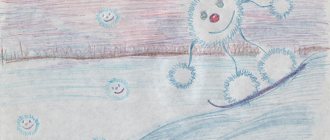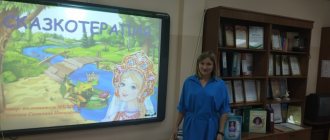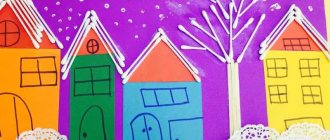Presentation on the topic Productive activities of preschool children in kindergarten
Slide text: INFORMATION SUPPORT OF DISCIPLINE
1. 1. Federal State Standard for Preschool Education (Order of the Ministry of Education and Science No. 1155 of October 17, 2013, registered with the Ministry of Justice of Russia on November 14, 2013, registration No. 30384), came into force on January 1, 2014 [electronic resource]: Access mode : https://www.firo.ru/?page_id=11003 Grigorieva G.G. Development of a preschooler in visual arts: Textbook for students. higher ped. textbook institutions - M.: Publishing house, 2008. -344 p. 2. Davydova G.N. Non-traditional drawing techniques in kindergarten: Leisure and creativity of children; Part 1 – M.: Publishing house “Scriptorium 2003”, 2007. – 88 p. Davydova G.N. Non-traditional drawing techniques in kindergarten: Leisure and creativity of children; Part 2 – M.: Publishing house “Scriptorium 2003”, 2007. –78 p. 3. Komarova T.S. Drawing for middle and older ages from the “Wonderland” series. - M.: AST Publishing House, 2005. - 64 p. 4.Korotkova. E.A. Drawing, application, design in kindergarten. – Yaroslavl: Academy of Development, 2010. – 129 p. Lykova I.A. Visual activities in kindergarten: planning, notes, methodological recommendations. Junior group - M.: Publishing house "Karapuz-Didaktika", 2007. - 192 p. 5. Lykova I.A. Visual activities in kindergarten: planning, notes, methodological recommendations. Middle group - M.: Publishing house "Karapuz-Didaktika", 2010. -144 p. 6. Lykova I.A. Visual activities in kindergarten: planning, notes, methodological recommendations. Senior group - M.: Publishing house "Karapuz-Didaktika", 2009. - 208 p. 7. Lykova I.A. Visual activities in kindergarten: planning, notes, methodological recommendations. Preparatory group - M.: Publishing house "Karapuz-Didaktika", 2008. -208 p. 8. Lykova I.A. We sculpted, we played: Educational manual - M.: Publishing house "Karapuz-Didactics", 2007. - 80 p. 9. Lykova I.A. Program of artistic education, training, development of children 2-7 years old “Colored palms” - M.: Publishing house “Karapuz-Didaktika”, 2007. – 176 p. 10. Pogodina S. Theoretical and methodological foundations for organizing productive activities of preschool children - M..2015 11.. Potapova E. Visual activity and artistic work using modern materials in preschool educational institutions. - M.: Detstvo-Press, 2012.- 96 pp. 12. Approximate basic general education program “From birth to school” / ed. N.E. Veraksy, T.S. Komarova, M.A. Vasilyeva – M.: Mozaika-Sintez 2010. – 304 p. 13.. Pyatakova O.A. Materials for the course “Workshop on artistic work and design.” Noginsk branch of MGOU, 2012. 14.. Shvaiko T.V. Classes in visual arts in kindergarten: Program, notes - M.: VLADOS, 2005. - 144 p.
Bottom line
As you can see, productive skills developed in preschool age have a lot of advantages:
- development of the pupil’s aesthetic and moral feelings;
- improving his mental and physical aspects;
- formation of concepts about space, form, composition;
- acquisition of additional skills in working with tools and office supplies;
- development of perseverance, hard work, logic.
And in order to achieve all this, you don’t need to do much: provide the baby with all the necessary materials and together with him try to make a craft, sculpt a figurine or draw a picture.
This will bring pleasure to both you and your child, and will help him take another step towards his successful education. leave a comment
MAGAZINE Preschooler.RF
MAIN TYPES OF ACTIVITIES OF CHILDREN 3-4 YEARS OLD An important indicator of a child’s development is the level of his mastery of various types of children’s activities. game Game is the leading activity of a preschooler. The most significant changes in the child’s psyche occur in play. These changes prepare him for a new stage of development. Thinking and imagination develop in the game. Role-playing game Three-year-old children feel independent and are ready to do everything like adults. Children themselves do not name roles; they simply perform roles (roles in action), carrying out individual play actions.The game is monotonous - as a rule, it is repetitions of the same operations (for example, feeding)
Despite the fact that play is a central characteristic of a child’s development, productive activities, and above all visual activity and design, are of great importance for him. CONSTRUCTION Children's design is an interesting, but quite complex practical activity. Children 3-4 years old can carry out targeted actions to create simple structures from building materials. By the age of 4, children: - distinguish and correctly name the main parts of building materials (cube, brick, prism), concepts (high-low, wide-narrow, long-short); -designed according to a ready-made model; -construct elementary object structures consisting of 2-3 main parts;
Drawing A 3-4 year old child creates a schematic drawing of an object. the image is ahead of the concept. When starting to draw, a child does not know what he will succeed in. If the image turns out not very similar to what was planned, he will easily change his mind: “The car didn’t turn out well, it’s a pussy.”
The richer the child’s world, the more interesting his drawings will be. Applique Applique is a way of creating artistic images from various figures, cut out of any material and pasted onto a certain background. By the age of 4, children: - lay out and paste elements of decorative applique on a strip, square , using first the same, and then different in color, shape and size of the figure; - compose and paste simple schematic images (beads, balloons, handkerchiefs, flags on a string) and more complex ones (fungus, house) In early preschool age, due to insufficient development of small muscles of the hand, poor coordination of movements and visual control over their actions, children They do not work with scissors; they applique from ready-made geometric shapes.
Development of motor skills Indicators of the development of motor skills of children 3-4 years old: - the child can walk along a gymnastic bench; - hits the ball on the floor and circles it with both hands (3-4 times) - transfers small objects (from the table to the box)
Indicators of mental development 4 years PERCEPTION - can select one card from several by the name of color or shape - can select objects or building parts according to a certain shape - can match 5-7 objects of the same shape by size. -uses prepositional words in speech. THINKING - can, according to the scheme proposed by an adult, assemble a simple building from cubes (4-5 parts) IMAGINATION - can give several answers to the question: “what does the figure look like?”; completes an unfinished fairy tale with 2-3 sentences. Indicators of speech development Phonetic side of speech A child can engage in onomatopoeic exercises, pronouncing loud vowel sounds. He develops a special sensitivity to the sound side of speech
Grammatical structure of speech The child actively uses grammatical forms. Distinguishes between singular and plural objects (dishes, clothes, toys). Correctly uses words denoting baby animals, identifies the characteristics of objects (shape, color, size), understands the purpose of prepositions, uses different intonations (interrogative, narrative, motivating) Social development Play interaction 3-4 years In the beginning, play nearby. Children participate in joint pranks. By the end, they are able to attract another child to play. 2-3 people unite for it. But roles are not yet distributed, there is no interaction between characters, and the gaming desires of the other are not taken into account. Thank you for your attention!
| Next > |
Why is it important?
It may seem that too much attention is paid to such simple activities as modeling, drawing and assembling construction sets. From the outside it is not visible what efforts the child makes, his development does not look obvious, because the improvement of skills occurs gradually. However, do not underestimate productive activities.
The modern education system, which is undergoing constant changes, has recently come to the point that kindergartens have become part of the entire system. Simply put, a child’s development begins in the notorious “kindergarten.” There, experienced educators and teachers will help the child unlock his potential and develop all his positive qualities to the maximum.
Child development is the main task of preschool education
In the field of education, a child becomes not an object to be influenced, but a subject who himself plays a central role in his own development.
In other words, it is not the teacher who should “push” knowledge into the student, but the child himself who should strive to obtain the necessary information. This phenomenon appeared thanks to the humanization and democratization of education, when attention moves from the teacher to the student, and it is the latter who becomes the center of the educational process.
Improving the skills acquired in a preschool institution with parents will help both adults and children: it will be easier for you to understand your child, and he, in turn, will be pleased to demonstrate to his family what he can do. This is why it is important and necessary to develop productive skills.
Productive activity for preschoolers: drawing
Kids especially love to draw. Here they have scope for imagination, everything is depicted on paper: heroes of fairy tales, space, forests, individual objects, patterns, scenes experienced in life - here the child fully realizes his thinking. By drawing, children once again relive the emotions they have experienced and reveal their thoughts. Usually, a drawing task is given on independent topics, that is, everyone decides for themselves what, how and in what color to depict. From the drawings you can judge the baby’s character and find out his fears that he keeps to himself. Sometimes it is recommended to visit a psychologist so that he can solve the child’s problem and correct his understanding of the world around him.
Formation of productive activity of a preschooler
It is necessary to properly develop a training program. Children should not be doing the same thing every day. If your child loves to draw, but does not want to design or sculpt, you need to interest him. Ask to build or sculpt your house, and after it is ready, let him tell you about it, about where it is, where he likes to walk.
It is necessary to talk about the finished products, be it a drawing or an applique. At this time, speech is formed and vocabulary is replenished. For example, a child drew a kitten. Let him come up with a nickname, tell him about his character, preferences in food and games - this is creative thinking.
Productive activity is necessary not only for preschoolers, but also for primary school students. Many schools have created children's creativity centers, which are a great help in learning.
Objectives and classification of productive activities
In preschool, tasks and goals of productive activities are necessary to evoke emotions in the child about objects. This is how he begins his acquaintance with the surrounding space and develops skills in using the means of fine art. The child’s imagination is formed and developed, and a desire and interest appears to carry out productive activities. In creative work, children show themselves as creative individuals.
By mastering visual arts, you can see the level of preparation for studying at school. Artistic work is characterized by special guidance. Parents and teachers must guide the child in this process, for which it is necessary to use tips. An example are bright illustrations, books, manuals and brochures. When developing productive activities, the child will in any case need the help of elders.
Productive activities of a preschooler are classified:
- Familiarity with visual material;
- Improving sensory abilities;
- Development of fine motor skills and coordination of movements;
- Getting to know the world and people around you;
- Entertainment of a musical nature.
Among the ways to identify preschoolers’ abilities for productive activities are speech exercises, motor games, finger games, and manipulative games. Speech exercise focuses on speech development. With its help, sound pronunciation and correct orientation in space are trained. Such exercises are needed to consolidate vocabulary.
Subject to development in the process of motor play, the child’s motor activity and coordination of movements are formed. General motor skills are developing. Finger games are used to train fingers and palms. These trainings are sometimes supplemented with learning the text.
During manipulative play, small toys or other objects are involved in the action. This activity is necessary for the development of hand-eye coordination. A musical game helps you do exercises accompanied by music or song lyrics.
What is the success of developing productive activities for older preschoolers?
Productive activities are effective in developing various mental processes in preschoolers.
When a child draws, he thinks about or plans the result of the image. This is how the imagination develops. One might say that creative imagination precedes the production of a product. In modeling and various types of applique, children also represent their impressions of what surrounds them in the world, how they relate to their surroundings.
The application will help your child become familiar with different ways of processing paper. Children of senior preschool age cut out, tear, crumple, twist, bend, fold, and glue paper or its individual parts.
In preschool art classes, children develop aesthetic perception.
Products created by children create a pleasant atmosphere of cooperation. Children enjoy working together. Such activities cultivate moral qualities in preschoolers; they develop hard work and responsiveness.
When children engage in design activities, they gain very good imaginative thinking skills.
Art classes, design, and modeling develop in children of senior preschool age various skills that will later be useful to them at school.
Classes primarily shape the emotional sphere of preschoolers.
Such activities are always accompanied by communication, so here we can talk about the development of speech. Creating crafts stimulates speech activity in children. Children imitate the speech of an adult; they develop in terms of dialogical speech.
Therefore, the types of activities we are considering develop the communicative functions of speech in older preschoolers.
Lesson results
It is necessary to create a system of activities for children. If the teacher correctly distributes productive activities, and all its types are involved, the result will be as follows:
- children will be developed creatively;
- the group will have an excellent psychological atmosphere;
- preschoolers will be well prepared for school classes.
Most often, productive activity connects several areas, such as creativity, socialization, cognition, labor, communication, and the safety of preschoolers. Artistic and productive activities and creativity help develop a child’s speech. At this age there are many problems with her, such as poverty (poor vocabulary), monosyllabicity, it consists only of simple sentences, and the words are far from beautiful and literary. For example: “what”, instead of “what”, “beautiful flower”, instead of “I like this flower because...”, but instead of “I don’t want this because...” you can hear “leave me alone”, and others expressions. Children need to be taught to speak beautifully and explain their preferences more fully and efficiently.
In addition, children receive moral education, consolidate the knowledge acquired in the learning process, and develop the necessary character qualities:
- activity;
- independence;
- observation;
- determination;
- patience;
- the desire to finish what you started;
- the ability to “sort out” the information received and assimilate it.
Productive activity also improves the physical condition of children. They become more cheerful, their mood improves, their overall tone increases, their character becomes more relaxed and active. After classes and during them, the child is active. It is important to immediately correctly form his posture, gait, and body position, because all these qualities will be useful to the little man in the future. Productive activity allows you to coordinate movements, “tune” the vestibular apparatus, and strengthen the muscles.
Now we propose to get acquainted with the main types of productive activities. And at the same time we will note the features of each.
How to organize productive activities for children in older preschool age at a preschool educational institution
Organize productive activities in senior and preparatory groups of kindergarten according to thematic plans. Such classes are carried out in stages.
First, a system of entertaining productive activities is developed. For this purpose, various methodological and interactive literature is studied.
Many teachers, when organizing productive activities with children of senior preschool age, rely on the developments of a team of authors under the leadership of O.V. Dybina. the authors offer their own interesting ideas for carrying out non-traditional techniques.
One of the stages is the formation of basic competencies in children of senior preschool age. There are both creative abilities and the communicative side of the activity.



